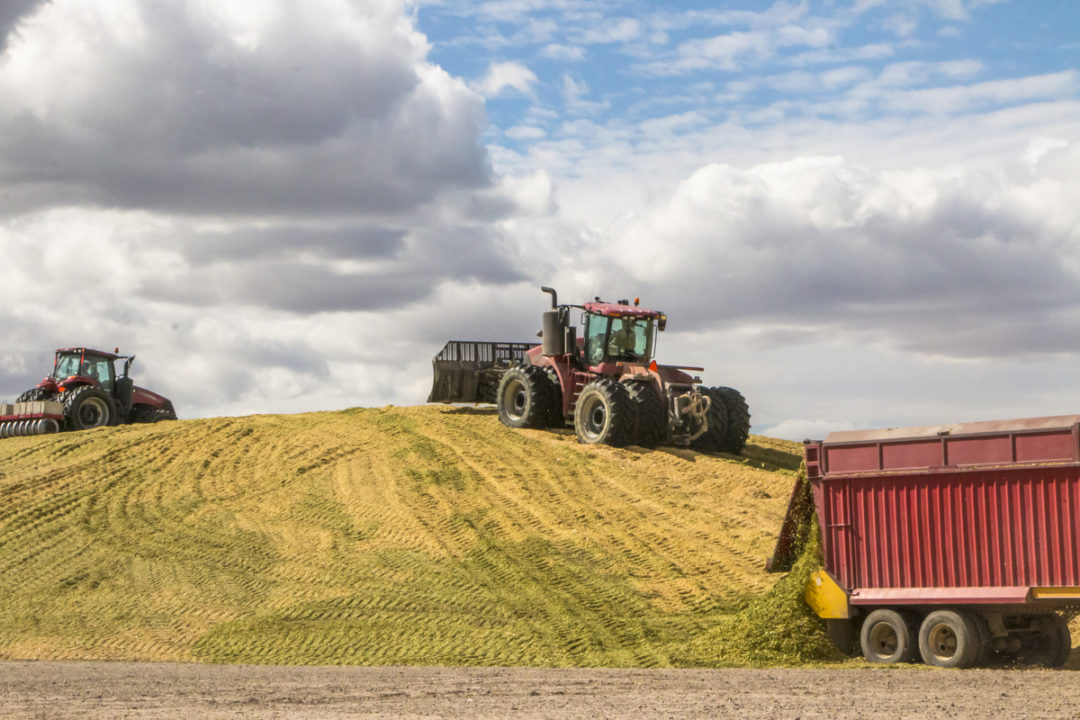A winning corn silage season can include a lot of little wins … like no down tractor days, everyone staying safe and, of course, getting rain at the right times. As we get close to the final stretch – harvest – and taking home the prize – enough high-quality silage for the year – let’s review the numbers and best practices for harvesting, packing, ensiling and feedout.
Dry matter percentage: When it is time to harvest
A constant goal when harvesting corn silage is finding the balance between yield and optimal fermentation. Ultimately, you need enough corn silage for the year while also meeting dry matter (DM) benchmarks for proper fermentation.
- Harvesting at 35% DM is ideal for maximizing yield and maintaining silage quality.
Research tells us that harvesting too dry can lower starch digestibility. At a 40% DM or higher, the development of starch makes kernels harder to process at chopping. Fermentation is also negatively affected because the starch granules are more heavily imbedded and harder to break down. Consequently, while harvesting dry results in more tonnage, you will likely be sacrificing starch digestibility.
It is time to harvest when chopped samples are at 30% DM or higher.
- Use the 1/3 milk line stage as your "trigger" to start measuring the whole plant DM. Note that field samples will be about 2 percentage points drier than the silage from those fields when put into the pile.
- At 1/2 milk line, DM can vary from 28% to 38% due to factors like weather, hybrid and plant location. The best practice here is to measure for whole plant moisture. A DM range of 32% to 37% indicates that you should start harvesting.
High nitrate levels – A drought-stricken growing season can result in higher nitrate levels. Nitrates are water-soluble, and a good shower after a drought will prompt the plant to take up nitrates from the soil very quickly. It is best to wait five to seven days following rainfall before harvesting. Cloudy and cool weather can also increase nitrates.
- Reduce nitrates by 40% to 50% by giving silage at least three weeks of fermentation before feeding out.
Packing, shaking, ensiling: Know your numbers
Packing – Doing the math when packing the pile is critical for creating the proper anaerobic environment for fermentation and for lowering shrink. Density (pounds of forage per cubic foot) is used to measure the success of packing silage. Pile density is influenced by crop, chop length, DM percentage, type of structure, delivery rate, packing weight and time.
Regarding shrink, density also has an impact on spoilage since a less-dense pile allows for more oxygen to enter. A Wisconsin study shows that silage density of 16 pounds of DM per cubic foot had a 15% loss, where 10 pounds of DM per cubic foot equals a 20% loss (Table 1).
- Target density for a bunker silo is 40 to 45 pounds as fresh forage or 14 to 16 pounds of dry matter per cubic foot.
- Find proper load tonnage by multiplying the packing tractor weight by 2.5. For example, a 50,000-pound tractor should not load more than 62.5 tons per hour.
- Thin (less than 6-inch) layers packed over and over will ensure enough weight for each layer to reach desired density.

Particle size – Ensuring a proper chop length is important for two reasons: excluding oxygen at ensiling and supplying enough physically effective neutral detergent fiber (peNDF) to support rumen function.
- Chop corn silage at 5/8-to-3/4-inch theoretical length of cut.
I recommend using the Penn State Shaker Box routinely throughout the duration of harvest to assess particle size. The ideal chop length should show this in the box:
- Above top sieve – Less than 12% of sample and no long leaves
- In the pan – Less than 10% of sample
- All kernels should be processed (no full kernels)
The Penn State Shaker Box also measures the corn silage processing score (CSPS). This defines the percentage of starch passing through the 4.75-mm sieve (third sieve).
- 70% or higher passing through the third sieve is considered optimal processing; 55% is adequate.
Ensiling – Covering and sealing silage correctly is the most crucial factor for fermenting silage and creating an anaerobic environment. Additionally, inoculants and stabilizers can aid the fermentation process and alleviate mold and mycotoxins at the bunk. Different inoculants are available for both scenarios of silage being "too wet" and "too dry." For reference, 85% of farmers are using some sort of forage preservative applied either at harvest or in the mixer wagon.
- Apply the necessary inoculants at harvest. In most cases, the solution is mixed in a tank on the harvester and then applied through a hose to the chopped wet forage.
- Cover with 4-millimeter-thick plastic that is designed to resist tears and block ultraviolet (UV) light or use an oxygen-limiting film next to the silage and a black/white UV plastic on top of it.
- Weight is necessary to prevent air infiltration. Use either old tires or tire sidewalls and touch each tire or slightly overlap when covering the entire pile.
- Add TMR stabilizers to the mixer wagon if mold is visible and/or a feed sample shows a yeast count greater than 100,000 and/or a mold count greater than 10,000.
Feedout: Your silage’s nutrient value
Now let’s consider your silage’s nutrient value. To do this, we will identify key nutrient values for deciding feedout readiness.
Table 2 compares the nutrient profiles of three corn silages at different fermentation lengths and CSPS. Looking at the "Fully Fermented CS" and the "Fully Fermented CS with High CSPS," we see a CSPS of 55 and 75, respectively. This difference creates nearly a 3% drop in corn silage rumen-digestible starch (22.98% compared to 25.16%). Cows fed the lower CSPS corn silage will require up to 4 pounds more of ground corn to make up the lost rumen-digestible starch in the diet.

In summary, knowing the numbers and best practices for corn silage harvest can maximize your income over feed cost. It can also help you have enough high-quality forage for the year. Work with your nutritionist to plan and execute a strategy, and best of luck this corn silage season.
References omitted but are available upon request by sending an email to the editor.




